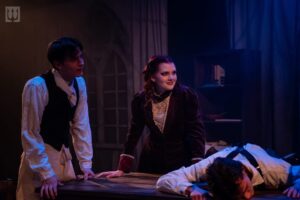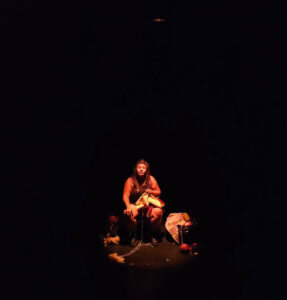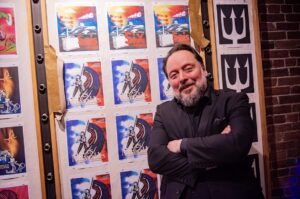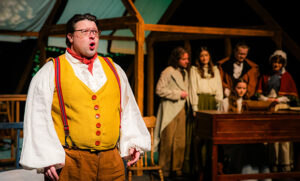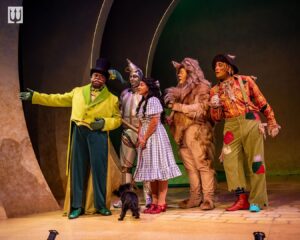Feathers and Loam is a play about an artist, as much as it is a play about a painting. The painting is Landscape with the Fall of Icarus which was painted by Pieter Breugel (1554-5). This play raises questions about the nature of artistry and creativity and whether it is more important to dedicate our lives in pursuit of flight, to travel and to see beyond our natural realms of knowledge facing the risk that we may fall and we may drown, or if it is more important to keep our head down, to provide sustenance for ourselves and our families and to remain deeply engrained in the back and forth monotony of our lives.
This play reminded me, of course, of Stephen Sondheim’s musical Sunday in the Park with George, but more specifically it made me think about the line, “work is what you do for others, Liebchen, art is what you do for yourself.” Playwright J. A. Wainwright sets up the dichotomy as Icarus represents lofty ambition, and the drive to see beyond the mundane present and into the future. He represents a dreamer, but, it is later revealed that he cannot be called an artist, because he is interested only in the product, and not in the process of his work. The ploughman is interested only in meeting today’s quota and providing for himself and his family in a practical, simple and honest way. Yet, the ploughman appreciates the artistry of nature, and the connectedness he feels with the world’s past- living off the land of his father and grandfather, and holding the earth in his hands.
The questions that Wainwright raises are interesting to consider, and his use of language is both poetic and reminiscent of the painting itself. I did wonder at times if it would have been more effective for Wainwright to weave the debates about who leads a better life, the pragmatic or the imaginative, more tightly into the plot because at times the play does feel a bit too much like a dramatized debate. I was also unclear about the role of the artist in this debate. Since we have no proof of men actually constructing wings for themselves (beyond those who have built hot air balloons and airplanes), it seems like the artists and the inventors are the closest equivalent we have to Icarus. It is true that Breugel is able to capture a moment on canvas, but the mere aspect of creating something new, “a hat, where there never was a hat,” suggests that artists are always foreseeing, as well as often harkening backward. I found myself wondering how Peiter fed himself, for he did not seem to me to represent the balance between the ploughman and Icarus. These ideas are not easily pinned down, indeed they spawn continuous streams of thought of overlapping opinions that would take ages to dissect and analyze properly.
Feathers and Loam is well directed by David Overton, who uses the space well and keeps the action moving nicely. I wondered why he chose to have Allison MacDougall and Ann Doyle sing during the scene transitions and whether there was some significance beyond being an interlude of lovely voices. The music does not at all detract from the play; it just seems like a curious choice.
The acting was well executed by the actors. Eric Benson makes a particularly earnest and daydreamy Icarus, while Rhys Bevan-John counteracts him nicely as a very grounded, earthy ploughman. Bevan-John is especially skilled at the physicality of his character, especially when miming the plowing of his field. Ann Doyle makes an equally sensible ploughman’s wife, although I wished that her character had been given a bit more of an enriched role in the story. Allison MacDougall’s muse, coy and delightful, makes reference to the woman’s role in creativity, but her relationship with the ploughman’s wife, and the richness of the feminist perspective could benefit from some development. Shawn Duggan plays a very focused Pieter, although he seems to facilitate the needs of the other characters without having a strong enough personality of his own.
I found Feathers and Loam to be a very interesting play, and it introduced me to this painting and the myth of Icarus (I don’t know how I’ve gotten through six years of in-depth study of theatre with such a meager knowledge of Greek and Roman myth, but I have) in an alluring way. We cannot look to art for answers, as so often it only complicates our understanding of the world. It is ploughman who dominates Breugel’s painting. What does this symbolize? “But to see…” If you look long enough, it will leave an impression.
This play reminded me, of course, of Stephen Sondheim’s musical Sunday in the Park with George, but more specifically it made me think about the line, “work is what you do for others, Liebchen, art is what you do for yourself.” Playwright J. A. Wainwright sets up the dichotomy as Icarus represents lofty ambition, and the drive to see beyond the mundane present and into the future. He represents a dreamer, but, it is later revealed that he cannot be called an artist, because he is interested only in the product, and not in the process of his work. The ploughman is interested only in meeting today’s quota and providing for himself and his family in a practical, simple and honest way. Yet, the ploughman appreciates the artistry of nature, and the connectedness he feels with the world’s past- living off the land of his father and grandfather, and holding the earth in his hands.
The questions that Wainwright raises are interesting to consider, and his use of language is both poetic and reminiscent of the painting itself. I did wonder at times if it would have been more effective for Wainwright to weave the debates about who leads a better life, the pragmatic or the imaginative, more tightly into the plot because at times the play does feel a bit too much like a dramatized debate. I was also unclear about the role of the artist in this debate. Since we have no proof of men actually constructing wings for themselves (beyond those who have built hot air balloons and airplanes), it seems like the artists and the inventors are the closest equivalent we have to Icarus. It is true that Breugel is able to capture a moment on canvas, but the mere aspect of creating something new, “a hat, where there never was a hat,” suggests that artists are always foreseeing, as well as often harkening backward. I found myself wondering how Peiter fed himself, for he did not seem to me to represent the balance between the ploughman and Icarus. These ideas are not easily pinned down, indeed they spawn continuous streams of thought of overlapping opinions that would take ages to dissect and analyze properly.
Feathers and Loam is well directed by David Overton, who uses the space well and keeps the action moving nicely. I wondered why he chose to have Allison MacDougall and Ann Doyle sing during the scene transitions and whether there was some significance beyond being an interlude of lovely voices. The music does not at all detract from the play; it just seems like a curious choice.
The acting was well executed by the actors. Eric Benson makes a particularly earnest and daydreamy Icarus, while Rhys Bevan-John counteracts him nicely as a very grounded, earthy ploughman. Bevan-John is especially skilled at the physicality of his character, especially when miming the plowing of his field. Ann Doyle makes an equally sensible ploughman’s wife, although I wished that her character had been given a bit more of an enriched role in the story. Allison MacDougall’s muse, coy and delightful, makes reference to the woman’s role in creativity, but her relationship with the ploughman’s wife, and the richness of the feminist perspective could benefit from some development. Shawn Duggan plays a very focused Pieter, although he seems to facilitate the needs of the other characters without having a strong enough personality of his own.
I found Feathers and Loam to be a very interesting play, and it introduced me to this painting and the myth of Icarus (I don’t know how I’ve gotten through six years of in-depth study of theatre with such a meager knowledge of Greek and Roman myth, but I have) in an alluring way. We cannot look to art for answers, as so often it only complicates our understanding of the world. It is ploughman who dominates Breugel’s painting. What does this symbolize? “But to see…” If you look long enough, it will leave an impression.
Venue: Bus Stop Theatre (2203 Gottingen Street) $4.00
Times: Thurs Sept 10 at 8:50pm, Fri Sept 11 at 9:10pm, Sat Sept 12 at 4:40pm, Sat Sept 12 at 6:50pm, Sun Sept 13 at 2:30pm, Sun Sept 13 at 7:30pm


